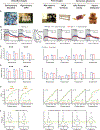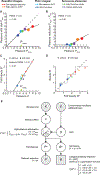Beauty Requires Thought
- PMID: 28502660
- PMCID: PMC6778408
- DOI: 10.1016/j.cub.2017.04.018
Beauty Requires Thought
Erratum in
-
Beauty Requires Thought.Curr Biol. 2017 Jun 5;27(11):1706. doi: 10.1016/j.cub.2017.05.045. Curr Biol. 2017. PMID: 28586658 No abstract available.
Abstract
The experience of beauty is a pleasure, but common sense and philosophy suggest that feeling beauty differs from sensuous pleasures such as eating or sex. Immanuel Kant [1, 2] claimed that experiencing beauty requires thought but that sensuous pleasure can be enjoyed without thought and cannot be beautiful. These venerable hypotheses persist in models of aesthetic processing [3-7] but have never been tested. Here, participants continuously rated the pleasure felt from a nominally beautiful or non-beautiful stimulus and then judged whether they had experienced beauty. The stimuli, which engage various senses, included seeing images, tasting candy, and touching a teddy bear. The observer reported the feelings that the stimulus evoked. The time course of pleasure, across stimuli, is well-fit by a model with one free parameter: pleasure amplitude. Pleasure amplitude increases linearly with the feeling of beauty. To test Kant's claim of a need for thought, we reduce cognitive capacity by adding a "two-back" task to distract the observer's thoughts. The distraction greatly reduces the beauty and pleasure experienced from stimuli that otherwise produce strong pleasure and spares that of less-pleasant stimuli. We also find that strong pleasure is always beautiful, whether produced reliably by beautiful stimuli or just occasionally by sensuous stimuli. In sum, we confirm Kant's claim that only the pleasure associated with feeling beauty requires thought and disprove his claim that sensuous pleasures cannot be beautiful.
Keywords: Kant; aesthetics; beauty; emotiontracker; pleasure; psychophysics.
Copyright © 2017 The Authors. Published by Elsevier Ltd.. All rights reserved.
Conflict of interest statement
Figures



Comment in
-
Commentary: Beauty Requires Thought.Front Psychol. 2017 Aug 2;8:1281. doi: 10.3389/fpsyg.2017.01281. eCollection 2017. Front Psychol. 2017. PMID: 28824481 Free PMC article. No abstract available.
References
-
- Kant I (1764/2004). Observations on the Feeling of the Beautiful and Sublime. (Berkeley: University of California Press; ).
-
- Kant I (1790/2000). Critique of the Power of Judgment. (New York: Cambridge University Press; ).
-
- Armstrong T and Detweiler-Bedell B (2008). Beauty as an emotion: The exhilarating prospect of mastering a challenging world. Rev. Gen. Psychol 12(4), 305–329
-
- Graf LKM and Landwehr JR (2015). A dual-process perspective on fluency-based aesthetics: The pleasure-interest model of aesthetic liking. Personal. Soc. Psychol. Rev 19, 395–410. - PubMed
-
- Leder H (2013). Next steps in neuroaesthetics: Which processes and processing stages to study? Psychology of Aesthetics, Creativity, and the Arts 7, 27–37.
MeSH terms
Grants and funding
LinkOut - more resources
Full Text Sources
Other Literature Sources

